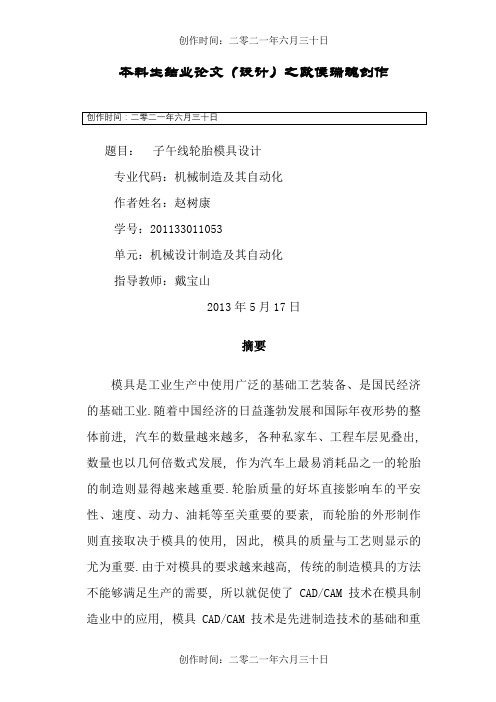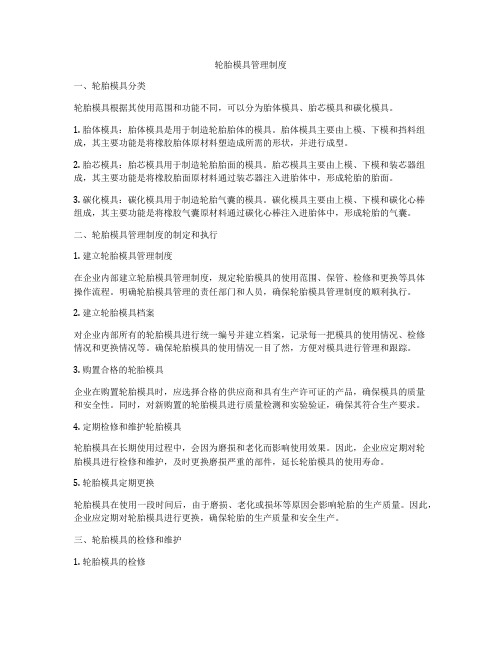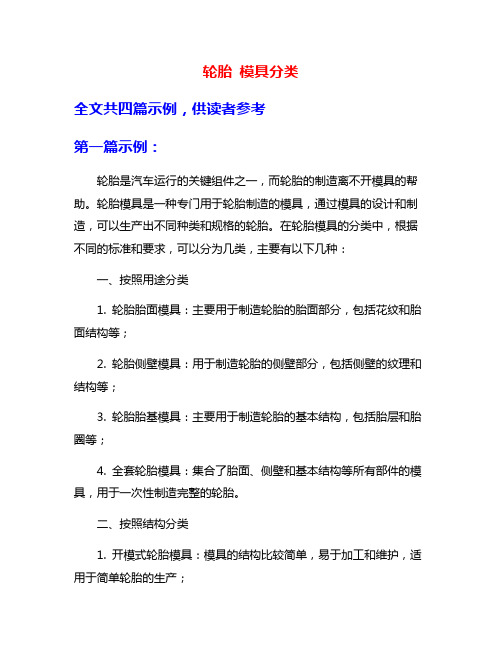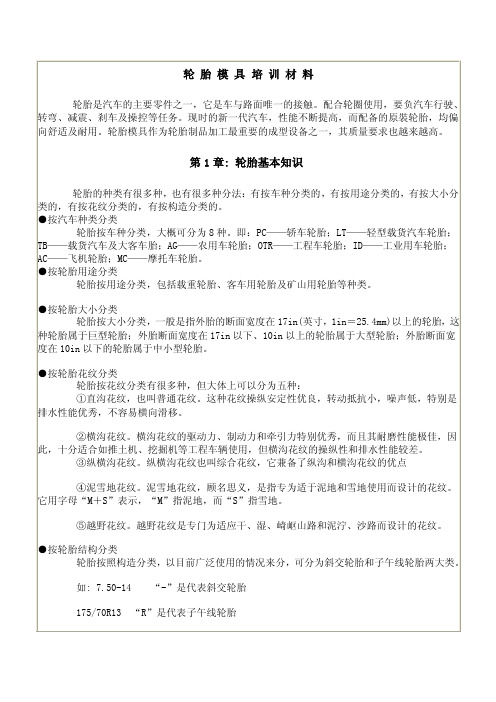1. 轮胎模具简介
轮胎模具设计说明书

本科生结业论文(设计)之欧侯瑞魂创作题目:子午线轮胎模具设计专业代码:机械制造及其自动化作者姓名:赵树康学号:201133011053单元:机械设计制造及其自动化指导教师:戴宝山2013年5月17日摘要模具是工业生产中使用广泛的基础工艺装备、是国民经济的基础工业.随着中国经济的日益蓬勃发展和国际年夜形势的整体前进, 汽车的数量越来越多, 各种私家车、工程车层见叠出, 数量也以几何倍数式发展, 作为汽车上最易消耗品之一的轮胎的制造则显得越来越重要.轮胎质量的好坏直接影响车的平安性、速度、动力、油耗等至关重要的要素, 而轮胎的外形制作则直接取决于模具的使用, 因此, 模具的质量与工艺则显示的尤为重要.由于对模具的要求越来越高, 传统的制造模具的方法不能够满足生产的需要, 所以就促使了CAD/CAM技术在模具制造业中的应用, 模具CAD/CAM 技术是先进制造技术的基础和重要组成部份, 正在向着集成化、网络化、智能化的方向发展.在模具厂增多, 面临的压力逐渐增年夜的情况下, 提高模具的质量成了首当其冲的问题.其流程规范化, 工艺标准化成了一个不成阻挡的年夜潮水, 只有流程与工艺有了标准后才不至于呈现同规格型号轮胎有略微纷歧样的情况, 因为我们知道, 一辆汽车四个轮胎如果分歧超越了一个度那在平安系数等方面是极其危险的.所以我们需要制定统一流程化.标准化是很有需要的一个年夜趋势.课题首先对现在流行的CAD/CAM技术及其优越性进行了简单介绍, 而UG是CAD/CAM软件的代表, 具有工程制图、三维造型、机构分析、动画仿真等强年夜功能, 所以本文对UG的功能在模具制造中的应用进行了研究、分析.最后分别介绍了在CAD/CAM技术下模具制造的三年夜块, 结构、花纹以及刻字.关键词:轮胎花纹、侧板刻字、CAD/CAM技术、轮胎结构、活络模装配AbstractIn recent years, with the rapid development of the automotive industry and a significant increase in car ownership, making cars increasingly close links with the people's life, traffic safety issues are increasingly prominent. Increase in car accidents caused by the loss of life and property damage, have become a social problem that cannot be ignored. Automobile safety is very important.Automobile safety design as a whole takes into account, in the time of the accident to minimize the chance of occupant injuries, so the passive safety of vehicles and related equipment increased by the majority of the people of concern.So we need a special type of brake lights, more intuitive, more visual impact of the brake signal to remind the rear vehicle drivers identify emergency stop or slow brake in a timely manner, so as to more effectively reduce vehicle collision occurs.This device is designed by brake pedal travel, which make multiple high brake rear lanterns lit and extinguished one by one,its working principle is mainly driven by the brake pedal pressure sensors transmit electrical signals, by single-chip computer to receive and process signals,thus decided to connect or disconnect the brake lights set, multiple high brake rear lanterns lit and extinguished one by one, final warning reached the rear of vehicle drivers.Keywords:traffic safety; brake lights; pressure sensor; brakes and slow brake目录第1章绪论51.1 子午线轮胎简介及其特点1.2 模具CAD/CAM技术及其优越性1.3 UG/GRIP介绍第2章子午线轮胎模具结构设计和装配62.1.2 模具的选材2.1.3 模具的设计特点和要求2.1.4 模具的精度和粗拙度要求2.2 活络模的装配2.2.1 建立活络模零部件三维模型2.2.2 装配过程2.3 本章小结8第3章子午线轮胎模具花纹设计93.1 子午线轮胎的花纹3.1.1 胎面花纹的组成与作用3.1.2 对胎面花纹的要求3.1.3 胎面花纹的类型3.1.4 花纹沟深度3.2 子午线轮胎花纹的造型3.2.1 编程实现曲线的空间转换3.2.2 由空间曲线生成三维实体3.3 子午线轮胎的模具造型3.3.1 轮胎造型3.3.2 模具造型第4章子午线轮胎模具侧板刻字4.1 轮胎侧板刻字的简单介绍4.2 Master cam Mill v8在轮胎侧板刻字中的应用4.2.1 Master cam Mill v8软件简单介绍4.2.2 Master cam Mill v8的功能4.2.3 Master cam Mill v8的优越性4.3 子午线轮胎刻字设计流程4.3.1 子午线轮胎侧板排字4.3.2 字体法式致谢参考文献21第1章绪论子午线轮胎区别于斜交轮胎, , 胎体帘线按子午线方向排列, 子午线轮胎根据资料分歧可以分为全钢丝、半钢丝和全纤维子午线轮胎三种类型.与斜交胎相比具有许多优点:使用寿命长、滚动阻力小, 油耗低、承载能力年夜、减震性好;子午线轮胎的缺点:轮胎胎侧较薄、侧向强度低, 稳定性能差、工艺复杂, 生产本钱高、不能与普通斜交胎用于同一辆汽车、严格坚持出厂时轮胎要求的标准气压等1.2 模具CAD/CAM技术及其优越性模具是把所需要的资料填充在他的型腔中, 用来获得需要的外部形状和基本尺寸的工具.依照加工方式和加工所用资料的分歧, 模具分类有橡胶模具、粉末模具、压铸模具等等模具的CAD和CAM技术是一项容易掌握的很高真个系统工种.是改变传统模具的老旧的加工方法的一个技术.它用计算机软件的形式作为加工工具, 使加工编程的技术工人能进行加工设计和不竭优化提高.模具的CAD和CAM技术的发展快, 给产物的加工设计, 制造和生产的水平的不竭的发展带来了巨年夜提升, 作为各种厂家不竭信息技术化, 集成技术化、网络技术化的最好的方面.近年来, 模具的不竭提高的制造的加工生技术在我国和其他国家都已经获得了迅猛的提升.经过几十年的发展, CAD/CAM技术已经在生产中占据了主导位置, 其代表软件有UG、Mastercam Mill、CA TIA , 他们有着优越的设计、加工完备、计算准确、很强的实用性, 可以从双轴加工到以五轴联动等分歧的方式加工复杂的产物, 减少了设计中的主观误差并利用了计算机各种优点来优化化方案, 保证方案的可行性, 同时使模具生产能够实现高精度、高自动化、高效率.极年夜地降低了生产本钱, 给模具制造业带来了巨年夜的经济效益.1.3 UG/GRIP介绍年夜部份的厂商在引进了CAD/CAM种种软件之后在工作中发现, 一般的CAD/CAM软件的功能虽然解决了他们的年夜部份需求, 可是许多专业问题, 例如贯彻本公司的标准、专业的设计方法和算法、产物管理以及数据处置等方面, 解决起来比力困难, 会遇到很多麻烦, 这就需要二次开发工具.CAD/CAM软件的本地化, 把本企业的专业知识、专利、规范等, 与通用的 CAD/CAM软件集成, 使之成为一个高效、易用的应用系统, 可以说, 这些应用系统就是他们研制新产物、介入市场竞争的法宝. GRIP是 Graphics Interactive Programming的缩写, 即图形交互语言, 是UG最主要的二次开发工具之一.由于GRIP语言与UG的紧密结合, 以及它的简单易学, 被称为面向工程师的语言.GRIP命令有三种暗示方式:(1)陈说格式例如, 用两个坐标点(0, 0, 0)和(10, 0, 0)生成一条直线, 其陈说格式的GRIP语句为: LN1=LINE/0, 0, 0, 10, 0, 0 又例如, 在直线 LN1的下方, 作一条间距为1.0的平行线, 其陈说格式为: LN=LINE/PARLEL, LN1, YSMALL, 1.0 其中:LINE为主词, PARLEL1, YSMALL为辅词.(2)GPA符号格式例如&DENS用于设置线宽.(3)EDA符号格式一般的一个GRIP法式都可分为五部份, 每个部份都要使用一组 GRIP命令(1)声明语句部份ENTITY/LN1,P(9),SPLN1,SPFREVSTRING/STR(30)NUMBER/A(10), CD(3)(2)初始化语句部份STR=’请输入刀具参数’DATA/A(10),1,1,2,0,5,1,3,4,5,7DATA/CD(3),4.5,1.2,4(3)交互语句部份GPOS/'选择一点',xc,yc,zc,respPARAM/'输入边长','长:',dx,'宽:',dy,$'高:',dz,resp第2章子午线轮胎模具结构设计和装配子午线轮胎活络模由动模和定模两部份组成, 也就是人们常说的上、下模, 上模包括上盖、中模套、滑块、上侧板、花纹块, 减磨板及导向机构等, 装置在硫化机移动模板上, 在成型过程中, 随合模系统运动;下模包括底座、下侧板, 下钢圈, 减磨板等, 装置在固定模板上.成型时, 上下模闭合, 充气的胶囊形成封闭的型腔, 成型的胚胎在胶囊外面, 在张力作用下贴合在型腔内壁, 高温保压进行硫化, 成型后开模取生产物.图2-1 轮胎活络模结构图(1)确保轮胎产物能够满足工艺结构产物要求, 内轮廓几何图形和钢圈参数, 花纹形状满足花纹字体图的要求.(2)能够与硫化机平安准确装置(几何图形, 参数要求, 孔的年夜小)准确无误.(3)一定确保模具有足够的强度、硬度和刚度.(4)那些没有隔热板罩的热板导热模具胎冠部位的厚度要比常型硫化机所装置使用的模具增加10%到15%的厚度, 确保使其能够平安的储藏所需的热容量.以用来满足硫化机工艺过程温度的均匀、稳定和平安.(5)结构设计合理, 加工制造工艺平安良好, 装卸平安快捷, 定位准确, 运输方便.(6)花纹圈分割面位置选取要合适, 要利于硫化后进行轮胎脱模.(7)排气槽跟排气孔的规划要合理, 不能影响模具的散热, 不能影响模具的硬度、刚度、平安, 不能影响客气的排出, 最好不影响模具的美观.(8)型腔的粗拙度和加工工艺的参数要选取合适, 模具要在保证工艺性的前提下提高其经济性, 固然要根据实际情况各有偏重.活络模对精度的要求非常高, 所以在选材时要充沛考虑资料的耐磨性、强韧性、疲劳断裂性能、高温性能、耐冷热疲劳性能、耐蚀性等特点, 来满足模具的可锻性、退火工艺性、切削加工性、氧化, 脱碳敏感性、淬硬性、淬透性等工艺要求, 同时还要尽可能的降低本钱满足经济性要求.除厂家要求外, 上下侧板、上盖、底座板等零件均采纳45钢, 锻件不能有缺陷并进行退火处置, 消除铸件内应力, 防止几何变形, 方便刻花把持.在粗加工后要进行二次热处置来消除加工过程中的加工应力.在焊接部位, 焊后要进行退火处置, 对硬度有特殊要求的还要进行氮化处置, 对有特殊要求的零件如滑块导向条等他们受力较年夜、工作环境比力恶劣, 一般选用40Cr.表2-1 资料明细表2.1.3 模具的设计特点和要求对模具来说要满足制品的设计和使用要求, 即产物的质量要求.模具产物的合理性会直接影响产物的外形尺寸、物理性能和外观质量, 要保证模具的质量就要从胶料的收缩率引起制品尺寸变动、排气、定位和分型面简直定等一系列问题上考虑, 在保证产物质量的前提下去研究和确定设计方案, 模具组装、装配、填料以及产物的取出要尽可能的简便, 提高生产效率, 降低工人的劳动强度.同时模具设计还应有利于机械化和自动化, 实现自动开模、顶出、闭模等举措, 年夜年夜的降低了劳动强度和提高了生产率.模具在工作时的外压和内压都很年夜, 因此模具资料的选择要合理, 使模具具有足够的机械强度, 同时在满足机械强度的要求下还要节约资料, 降低本钱.模具的加工和修理要方便, 模具设计在保证质量及产物寿命的前提下要尽可能简化制造工艺, 缩短生产周期, 降低生产本钱.综上可知, 模具在设计时要注意以下几点:(1)型腔尺寸准确;(2)具有足够的强度和刚度, 硫化时不容易变形;(3)结构简单、装配方便、便于清理;(4)便于装料、脱模, 排气容易.2.1.3 模具的精度和粗拙度要求模具的外形尺寸按GB1031-68第十四级公差带施工验收, 粗拙度上下面为Ra1.6, 其余为Ra3.2;模具的分型面局部间隙小于0.1mm, 钢圈分型面要低于外口分型面0.2-0.4mm;模具型腔轮廓按样板施工验收, 胎正面其余部位局部间隙长0.4mm;模体与钢圈的配合采纳GB1801-79, 基孔制8级公差带的动配合(Hs/f8);花纹几何形状按样板施工验收, 样板与花纹根部曲线单边局部间隙小于0.5mm;夹套式活络模必需依照受压容器检验的有关规定, 进行水压试验;模具组装后上下面不服行度小于0.5mm;各类轮胎模具商标、字体按图纸加工, 字迹清除、排列整齐.2.2 活络模的装配2.2.1 建立活络模零部件三维模型装配是以UG作为平台进行的, UG是CAD/CAM技术的代表之一, 被众多公司采纳, UG的功能非常强年夜, 涉及到平面工程制图、三维造型、机构分析、运动分析、制造和渲染等.CAD功能实现了目前制造业中惯例的工程设计和绘图自动化, CAM功能则为数控机床提供NC编程技术, 能够为分歧的用户提供分歧的开发工具, UG是一个完全集成的CAD/CAM软件集, 它致力于从概念设计到工程分析再到制作的整个过程, 它的设计过程是一个可反馈、可修改的过程.UG强年夜的参数化功能支持模型的实施修改, 系统能够自动刷新模型来满足设计要求, 所以这种设计过程可以在产物初步设计后就可以进行方案评审, 其实不竭进行修改设计, 一直到达到厂家的要求.UG实体建模提供草图设计、曲线生成、布尔运算、扫掠实体、旋转实体、沿导轨扫掠、尺寸驱动、界说和编纂变量及其表达式等工具图2-2 侧板图2-3 减磨板图2-4 花纹圈UG/User Defined Feature是用户自界说特征模块提供交互式方法来界说和存储基于用户自界说特征的, 便于调用和编纂的的零件族, 其形成用户专用的UDF库, 可以提高用户设计建模的效率, 该模块包括已生成的UG参数化模型中提取参数, 界说特征变量, 设置变量默认值, 界说代表该UDF的图标菜单的全部工具.图2-5 底座垫板在UG的装配模块中, 点击【添加组件】, 弹出“选择部件”对话框, 找到所要装配的零件, 然后“确定”所选择的零件就进入了UG的装配模型中, 点击【配对组件】, 弹出“配对条件”框.采纳自底而上的装配方式, 选择底座作为工作部件, 在装配类型中分别选择“平行”、“对齐”、“贴合”, 使底座的上概况和垫板的下概况“贴合”, 根据类似的方法把所有的部件都分别导进虚拟装配模型中, 进行总装配.首先进行底座板装配图2-6 底座装配而后完成上盖的装配图2-7 上盖装配弓形装配座图2-8 弓形座最后形成总装配图, 生成支持汉字的装配明细表.如图:图2-9 总装配图2.3 本章小结随着生活水平的提高, 对汽车的需求量增加, 招致汽车工艺的飞速发展, 对轮胎质量的要求也是越来越高, 子午线轮胎活络模具的发展为轮胎生产进入高质、高效的方向奠基了坚实的基础, 本课题设计的模具根据理论计算及实际情况, 初步确定活络模装置的整体结构及部件尺寸, 在进行造型, 采纳了立异的方法, 运用静态设计、机械结构优化设计、可靠性设计, 充沛体现了现代设计的设计与制造同步的先进理念, 缩短了设计周期、降低设计本钱为企业新产物的开发提供了有力的支持.第3章子午线轮胎模具花纹设计3.1 子午线轮胎的花纹3.1.1 轮胎花纹的组成与作用轮胎主要由三个部份组成:内胎、外胎、垫带.作为轮胎模具来说, 最复杂也是最重要的部份就是轮胎外胎上的花纹.花纹是轮胎上最终要的存在, 花纹的质量直接影响着使用性能和轮胎寿命.使用性能又包括着汽车的速度、动力、灵活度、油耗、散热、排水、排石、噪音等.如图3-1所示, 这是工程胎中典范的竖纹为主的花纹, 相对应的特点就是灵活性好、油耗低、速度相对来说快、抓地力强, 可是动力小, 适合长途运输的工程车.我们罕见的工程车中有三分之一以上采纳此种花纹.如图3-2所示, 这是工程胎中以横纹为主的花纹, 它的特点就是动力特别足、抓地能力强, 可是油耗高、速度相对较低、灵活性差.适用于短距离高强度运作的工程车.如图3-3所示, 完全以动力为主设计的花纹, 一般用于拖拉机之上.适用面比力窄.如图3-4所示, 实际生产中车的多用途致使不成能使用单一功能的花纹, 混合花纹的设计很好的弥补了这一点, 让各种性能之间有一个平衡.图 3-1图 3-2 图 3-3图 3-43.1.2 对胎面花纹的要求1.保证轮胎对空中的压力均衡, 只有压力均衡才华保证轮胎的耐磨损性, 有助于防止老化.2.横纹与竖纹的交接融合要比例适当, 多节距花纹各种节距的长度需要严格控制, 这有助于提高牵引力和制动力的传输效率.3.花筋角度和宽度的控制与是否添加排石块.这直接影响轮胎的散热、排水、排石.如果开口年夜小分歧适一旦车在行驶工程中在车胎内压入石子等会年夜年夜减少轮胎的寿命.4.减少封闭区域的花纹设计, 极易发生噪音且散热不均.5.外形上要求美观年夜方.6.考虑实际加工, 防止呈现加工干涉, 硫化和脱模困难.3.1.3 胎面花纹的类型花纹块面积占胎面面积的70%-90%, 经常使用于普通工程车和轿车, 其中轿车所用胎的花纹块面积占总胎面面积的80%-90%, 这是为了良好的抓地性能, 可是因为花纹块比力年夜, 不容易散热.图3-1、3-2、3-3、3-4都属于普通花纹.图3-5是轿车用的花纹.图3-5这种花纹一般应用区域较窄, 如图3-2的拖拉机用的花纹, 花纹块只占胎面面积的30%-40%.图3-6所示为泥地胎花纹, 此种花纹花筋深度年夜于普通花纹, 一般用于越野车和小型观光车, 花纹块面积占胎面积的40%-60%, 能适应路况较差和泥泞的路途, 且排水排石性良好, 不容易卡住石子.图3-6此花纹是一种过渡性花纹, 兼顾抓地性能和速度、抗磨损等.一般来说中间有一条纵向条纹花筋, 整体以网格状居多.随着各种车型的不竭开发相对应的花纹也跟着不竭的变动, 趋势是花纹越来越复杂, 精确度越来越高, 固然效果越来越趋近理想.3.1.4 花纹沟深度花纹沟深度与花纹的规格和适用车型有关.一般来说, 年夜规格轮胎的花纹要深, 越野轮胎要比普通花纹深20%-30%.花纹深的优点就是年夜幅度提高行程, 但耐磨性受到影响.取舍上根据轮胎定位来选择.3.2 子午线轮胎花纹造型图3-7为轮胎截面图, 轮胎年夜轮廓则是由此截面图旋转一周获得的.旋转得出轮胎的基本形状如图3-8.再加上花纹就会获得如图3-9所示的制品图.图3-7图3-8图3-9我们要想做出花纹除必需有曲线图(轮胎截面图)外还必需要有平面花纹图(如图3-10), 平面花纹图则是由三部份组成:花纹、剖视图(图3-11)、节距排列(图3-12).轮胎的3D造型是非常困难的, 原因年夜致分以下几个部份:(1)把持者需要年夜量的经验来在脑海中行成轮胎外形的基本样式.(2)花纹截面是个不竭变动的, 中间过渡需要无错台接合, 非常考验把持者对软件的理解和使用功底.(3)3D造型的目的是为了加工, 不单单是为了看效果, 所以, 造型的同时必需要考虑加工便捷, 尽量防止模型加工“干涉”.(4)严格依照图纸, 不能擅自修改截面和剖视图.(5)精确度要求高, 误差一般尽量控制在0.01—0.07mm, 因为模具直接影响轮胎的花纹成型.(6)对多节距花纹来说, 节距数量多, 工作量年夜, 保证各个节距能完美相接, 必需依照客户所要求的节距进行排列, 如图3-10, 年夜节距L长度为79.867mm, 小节距C长度为63.945mm, 我们独自做出L和C的花纹, 然后按图3-12排列出整圈花纹, 只有完美接圆, 花纹不错台才华继续加工.年夜小花纹参差有致, 能提高轮胎的性能, 更能接近我们的目标, 可是同时也年夜年夜的提高了轮胎模具的加工难度.图3-10图3-11图3-123.2.1 编程实现曲线的空间转化轮胎花纹造型的第一步就是实现花纹和曲线的空间化.为了把平面曲线转换为空间曲线, 曾想到采纳UG 的投射(project)命令, 将平面上所有的花纹曲线都“投影”到胎面上, 直接获得三维空间曲线.但用特殊点去验证, 发现所得的结果是不正确的, 特别在轮胎的两侧, 暗示得非常明显.有一点的X 坐标的设计数值应该为159.4974mm, 而结果却为156.3725mm, 相差3.1249mm.事实说明, 投射命令的应用范围是工业设计, 不适合有精确尺寸要求的设计.而环绕纠缠(wrap)命令运用的对象是圆柱体, 在胎面上不适合, 必需寻找其他更精确的造型方法.课题的进一步研究中, 采纳了函数转换方法.我们仔细研究了轮胎花纹的特点, 获得了以下两点结论, 根据这两条结论, 我们找到了轮胎花纹平面展开曲线转化为空间曲线的方法:(1)平面展开图中, M 轴上的点在三维图上有相同的Y 坐标值, y=0, 平行于M 轴的点在三维图上有相同的Y 坐标值, 具体数值需要经过计算;同样, 平面图中, N 轴上的点在三维图上有相同的X 坐标值, x=0, 平行于N 轴的点在三维图上有相同的X 坐标值, 具体数值需要经过计算.(2)平面展开图中, 假设存在一条平行于M 轴的直线, 那么, 直线在三维图上暗示为一条圆弧, 圆弧的弧长即是平面展开图上直线的长度.三维图上各点的坐标(X、Y、Z)与平面图形坐标(m、n)之间存在着如下关系:1)XOZ 坐标面上的点(图3-13)图中, O 为轮胎的回转中心, O1 为胎面圆弧中心, 对圆弧上任意一点A 有:α=360m/2πrx=rsinαy=0z=e+rcosα图3-132)YOZ 坐标面上的点(图3-14)YOZ 坐标面上的胎面是以半径为R 的圆.对任意点B 有:β=360n/2πRx=0y=Rsinβz=Rcosβ =(e+rcosα )cosβ图3-14( 3)不在坐标平面上的点α=360m/2πrβ=360n/2πRx=rsinαy=Rsinβz=(e+rcosα )cosβ (4.1)如果胎面圆弧的圆心不在 Z 轴上, 情况会比力复杂,如图3-15 所示,图中A 是圆弧SE 的圆心, r 是圆弧半径, δ是半径SA 与水平方向夹角,B 为圆弧上的任意一点.图3-15α=360(m-m1)/2πrβ=360n/2πRx=x1+rcos(180-α -δ )y=Rsinβz=(z1+rsin(180-α -δ ))cosβ (4.2)式中m1,x1,z1,δ为已知值.比较式( 4.1)和式( 4.2)可以发现, 式( 4.1)是式( 4.2)的特殊情况.3.2.2 由空间曲线生成三维实体(1)曲线整理及核对1、根据图纸胎顶径计算周长轮胎周长, 核对各节距长度是否和图纸长度符合, 计算各节距长度之和是否跟周长符合, 不符合联系厂家调整.2、整理轮廓曲线检查轮胎外轮廓弧长是否和平面图一致, 不符合联系厂家.3、根据厂家图纸整理轮胎节距图, 需要画气孔位置, 整理钢片位置长度, 暗示节距号等.根据整理好的节距图整理轮胎轮廓图, 圆周旋转花纹沟的剖面全部在CAD中手工画图, 以检测到UG中环绕纠缠曲线的位置是否正确.4、检查整理好的轮廓曲线和节距图纸, 无问题后另存为2004DXF格式, 将另存好的图纸翻开将不需要导入UG的曲线和标注删除, 然后执行CAD自带的清理法式, 以防止导入UG因软件分歧引起的毛病.导入UG的曲线必需保证是直线和圆弧, 多样线要打散, 导入UG前保证轮胎轮廓曲线的中心在CAD的坐标原点, 防止在UG加工过程中坐标系毛病, 引起的加工毛病.(2)CAD导入UG步伐及曲线整理:1、UG软件翻开创立空白模板, 保管至产物文件夹.2、文件/导入CADdxf、dwg\选择索要导入的文件, 导入到工作部件.3、将UG全部图层翻开, 以方便整理曲线.4、将轮廓曲线和截距曲线, 气孔分别放置到分歧的图层, 截距曲线颜色区分好.将轮廓曲线沿中心线(即X轴)旋转90度, 以保证轮廓曲线在Z轴上.5、根据厂家图纸排列轮胎展开图, 注意轮胎内外侧.排列后对平面图进行分瓣工作, 遁藏过小的较深的铝花筋, 横向花纹筋因为和分割位置接近平行, 考虑分割后接口也应当注意遁藏.(分瓣位置分瓣处置厂家有要求的尽量依照厂家)6、对分好的图纸添加快别代号、磨耗标识表记标帜等.(3)平面图转换到空间曲线.(曲线环绕纠缠)1、将轮廓曲线复制到备用图层, 编制整理轮廓曲线侧弧长长度即是平面展开图的长度备用.2、旋转调整好的轮廓曲线, 注意选择曲线的方向和矢量旋转起始角度, 防止环绕纠缠犯错.3、将坐标系放置到环绕纠缠曲线边框的定位点,。
1轮胎模具结构及制造流程介绍

轮胎模具结构及制造流程介绍一般轮胎模具按制造的工艺大致分两种:半钢,全钢。
半钢主要用于轮胎直接较小,花纹比较复杂的轿车轮胎模具,全钢相对于半钢主要用于卡车,工程车等等。
一套轮胎模具按结构一般分为两大部分:壳体和型腔。
轮胎模具的壳体部分对于同一厂家,相对比较固定,而型腔部分涉及到花纹曲线部则经常变化。
壳体部大致分:中套镶环,上盖,上盖开滑板,上盖闭滑板,T型块,中套,进出气嘴,中套滑板,导向条,弓形座,弓形座底板,底座滑板,底座,限位块等型腔部大致分:上侧模,花纹圈,上夹盘,副钢圈,下夹盘,下钢圈,下侧模等。
半钢与全钢轮胎模具的生产流程大体分设计,编程,加工,修花以及装配。
半钢模具工艺以型腔部分流程为例说明:设计---根据厂家要求设计出模具的壳体,型腔,壳体部分对于同一厂家基本就几个统一规格,不会有太大变化;型腔部分则根据厂家花纹进行设计,主要是对侧模字体的排列,花纹块的分块。
编程---根据厂家图纸要求利用软件做出花纹,上下侧模三维造型,并做出加工操作,最后生产NC代码(半钢型腔部分编程,主要是基准模编程,侧模刻字编程)加工---1.花纹块加工:五轴加工基准模(A,C轴摇篮式双摆台机床),利用基准模制作出硅胶,硅胶在反做成石膏,拼圆并铸造出铝花纹圈。
然后经过粗车,半精车,分块,铣立面,打气孔,修花,镶气孔套,拼圆,车口,拆胎,表面处理等完成对花纹加工;2.侧模加工:粗车,热处理,半精车,开槽,铣活字块,研块,车块,刻字(B,C四轴机床),打气孔,镶气孔套,精抛,表面处理等;3.上下钢圈,上下夹盘:粗车,热处理,半精车,刻气线,精车等全钢模具工艺型腔部分流程工艺:设计---根据厂家要求设计出模具的壳体,型腔,壳体部分对于同一厂家基本就几个统一规格,不会有太大变化;型腔部分则根据厂家花纹进行设计,主要是对侧模字体的排列,花纹块的分块编程---根据厂家图纸要求利用软件做出花纹,上下侧模三维造型,并做出加工操作,最后生产NC代码(全钢型腔编程主要根据不同工艺对花纹进行编程,以及侧模编程)加工---1.花纹块加工:根据工艺路线加工花纹,以整圈粗铣后电打为例说明,将环形锻件毛坯经过粗车,热处理,半精车,粗铣,电打,分块,铣立面,打气孔,修花,镶气孔套,拼圆,车口,拆胎,表面处理等;2.侧模加工:基本同半钢侧模加工路线。
轮胎模具行业分析报告

轮胎模具行业分析报告轮胎模具行业分析报告一、定义轮胎模具行业是针对轮胎的生产和修补所设计、制造和使用的模具,主要包括轮胎花纹模、芯仓模及斜口模等。
该行业一般涉及模具制造、修模、安装和维护等多个环节,其中主要生产企业集中在国内一些制造业发达的地区,如江苏、浙江、广东等省份。
近年来,随着汽车行业的迅速发展,轮胎模具行业发展也越来越火热。
二、分类特点轮胎模具行业依据其功能和用途,可以分为花纹模、芯仓模和斜口模三类。
其中,花纹模是指模具用于轮胎花纹的制作;芯仓模是轮胎成型过程中所需要的模具,用于轮胎的成型,并提供足够的压力;斜口模是指用于轮胎斜口部分的修整及热补。
轮胎模具行业的整个产业链是以轮胎制造为主线,涵盖了模具制造、模具修理、模具加工、模具设计、模具生产、模具成型、模具装配等多个环节。
三、产业链轮胎模具行业产业链比较完整。
主要包括模具材料、模具加工、模具制造、模具设计、模具修理、模具存储、模具自动化生产、模具检测等环节。
其中,模具加工是整个产业链的重要环节,其质量和速度直接决定了模具制造的成本和效率。
而在生产前期,模具设计和模具材料的选择也同样重要,不同材料的选择决定了模具的强度、耐磨性以及耐久性,从而影响整个模具生产效率。
四、发展历程轮胎模具行业始于20世纪60年代。
中国轮胎工业的起源可以追溯到新中国开国前,但那个时候还没有轮胎模具行业。
1965年,中国第一台173试制成功,开启了中国轮胎工业的历史,也为轮胎模具行业的创立打下了基础。
随着中国汽车制造业的迅速发展,轮胎模具行业也开始逐渐壮大。
2006年,中国轮胎模具工业园区在江苏省宿迁市成立,标志着轮胎模具行业迈向了更高的发展阶段。
目前,中国轮胎模具制造技术正逐步成熟,并拥有了完善的配套设施和较完整的行业产业链。
五、行业政策文件近年来,随着中国制造业的不断发展,轮胎模具行业的相关政策也越来越完善。
2015年,工信部印发《汽车工业发展“十三五”规划》,提出要推进汽车轮胎技术和产业的进一步发展。
轮胎模具行业发展趋势

THANKS
感谢您的观看。
培育自主创新能力
推动企业与高校、科研机构加强合作,建立自主创新联盟,提高轮 胎模具行业的自主创新能力。
提升知识产权保护意识
加强知识产权保护,鼓励企业申请专利,保护企业创新成果。
加强产业链协同创新,实现高质量发展
加强上下游合作
01
推动轮胎模具企业与上下游企业建立紧密的合作关系,共同开
发新产品,提高整个产业链的协同效应。
轮胎模具行业发展趋势
汇报人: 2023-11-19
CONTENTS
目 录
• 行业概述 • 轮胎模具市场现状及趋势 • 轮胎模具行业的技术创新与进
步 • 轮胎模具行业的重点发展方向
与路径 • 轮胎模具行业的政策支持与环
境保障 • 总结与展望
01 行业概述
CHAPTER
轮胎模具行业的定义与特点
定义
产业集群发展
地方政府积极推动轮胎模具产业集聚区建设,培育产业集群,促进产业链上下游企业协同发展。
社会各界对轮胎模具行业的关注与支持
金融机构支持
金融机构对轮胎模具行业给予信贷支持 ,为行业提供多元化的融资渠道,推动 行业的技术创新和产业升级。
VS
科研机构合作
轮胎模具企业与科研机构建立紧密合作关 系,共同开展技术研发和创新,提升行业 整体竞争力。
研发高性能材料
轮胎模具行业正积极研发高性能 材料,如高强度钢、耐磨钢等, 以提高模具的使用寿命和产品质 量。
制造技术不断进步
随着新材料和新工艺的不断涌现 ,轮胎模具行业的制造技术也在 不断进步,提高了模具的精度和 可靠性。
绿色环保与循环经济的实践探索
践行绿色环保理念
轮胎模具行业正积极践行绿色环保理念,采用环保材料和环保工艺,降低能源 消耗和减少环境污染。
轮胎模具管理制度

轮胎模具管理制度一、轮胎模具分类轮胎模具根据其使用范围和功能不同,可以分为胎体模具、胎芯模具和碳化模具。
1. 胎体模具:胎体模具是用于制造轮胎胎体的模具。
胎体模具主要由上模、下模和挡料组成,其主要功能是将橡胶胎体原材料塑造成所需的形状,并进行成型。
2. 胎芯模具:胎芯模具用于制造轮胎胎面的模具。
胎芯模具主要由上模、下模和装芯器组成,其主要功能是将橡胶胎面原材料通过装芯器注入进胎体中,形成轮胎的胎面。
3. 碳化模具:碳化模具用于制造轮胎气囊的模具。
碳化模具主要由上模、下模和碳化心棒组成,其主要功能是将橡胶气囊原材料通过碳化心棒注入进胎体中,形成轮胎的气囊。
二、轮胎模具管理制度的制定和执行1. 建立轮胎模具管理制度在企业内部建立轮胎模具管理制度,规定轮胎模具的使用范围、保管、检修和更换等具体操作流程。
明确轮胎模具管理的责任部门和人员,确保轮胎模具管理制度的顺利执行。
2. 建立轮胎模具档案对企业内部所有的轮胎模具进行统一编号并建立档案,记录每一把模具的使用情况、检修情况和更换情况等。
确保轮胎模具的使用情况一目了然,方便对模具进行管理和跟踪。
3. 购置合格的轮胎模具企业在购置轮胎模具时,应选择合格的供应商和具有生产许可证的产品,确保模具的质量和安全性。
同时,对新购置的轮胎模具进行质量检测和实验验证,确保其符合生产要求。
4. 定期检修和维护轮胎模具轮胎模具在长期使用过程中,会因为磨损和老化而影响使用效果。
因此,企业应定期对轮胎模具进行检修和维护,及时更换磨损严重的部件,延长轮胎模具的使用寿命。
5. 轮胎模具定期更换轮胎模具在使用一段时间后,由于磨损、老化或损坏等原因会影响轮胎的生产质量。
因此,企业应定期对轮胎模具进行更换,确保轮胎的生产质量和安全生产。
三、轮胎模具的检修和维护1. 轮胎模具的检修企业应建立轮胎模具的检修制度,确保对模具进行定期检查和维护。
检修时应仔细检查模具的各个部件,包括上模、下模、挡料、装芯器、碳化心棒等,发现问题及时处理。
轮胎模具产品方案

轮胎模具产品方案1. 引言本文档旨在介绍轮胎模具产品方案,包括轮胎模具的设计、制造和应用。
轮胎模具是轮胎生产过程中必不可少的工具,它可以塑造轮胎的形状以及提供轮胎的结构支撑。
轮胎模具的质量和精度对轮胎的性能和质量具有重要影响。
因此,合理的轮胎模具产品方案对于轮胎生产厂商来说非常重要。
2. 轮胎模具设计轮胎模具的设计是整个产品方案的关键环节。
合理的轮胎模具设计能够提高轮胎的成型效果和质量。
轮胎模具的设计需要考虑以下几个主要方面:2.1 轮胎形状设计轮胎的形状对于车辆的操控性能和舒适性有着直接影响。
因此,在轮胎模具的设计中,需要根据轮胎的使用需求和设计要求确定轮胎的形状。
同时,还需要考虑轮胎的外观美观和流线型设计,以提高车辆的整体造型和减小风阻。
2.2 轮胎结构设计轮胎的结构设计是轮胎模具设计的重要组成部分。
轮胎的结构包括胎体和胎面两部分,它们的结构决定了轮胎的承载能力和抓地力。
在轮胎模具的设计中,需要合理确定胎体和胎面的布局和结构,以提高轮胎的性能和寿命。
2.3 模具材料选择轮胎模具的材料选择直接影响着模具的耐磨性、耐腐蚀性和热传导性能。
常见的轮胎模具材料有铝合金、钢和复合材料等。
在选择轮胎模具材料时,需要考虑轮胎生产工艺和成本因素,以选择最适合的材料。
3. 轮胎模具制造轮胎模具的制造是根据设计方案制造出轮胎模具的过程。
轮胎模具的制造过程需要经过以下几个主要步骤:3.1 制造工艺规划制造工艺规划是制造轮胎模具的第一步。
根据设计方案和制造要求,制造工艺规划确定了轮胎模具的制造流程和工艺参数。
制造工艺规划需要考虑轮胎模具的材料,模具的结构和尺寸,以及制造设备和工艺流程等因素。
3.2 加工工艺选择加工工艺选择是根据轮胎模具的形状、尺寸和材料等因素选择相应的加工方法和加工设备。
常见的轮胎模具加工方法包括数控机床加工、电火花加工、线切割加工等。
加工工艺选择需要考虑加工精度、工艺复杂度和加工效率等因素。
3.3 制造工艺控制制造工艺控制是制造轮胎模具过程中的关键环节。
轮胎 模具分类

轮胎模具分类全文共四篇示例,供读者参考第一篇示例:轮胎是汽车运行的关键组件之一,而轮胎的制造离不开模具的帮助。
轮胎模具是一种专门用于轮胎制造的模具,通过模具的设计和制造,可以生产出不同种类和规格的轮胎。
在轮胎模具的分类中,根据不同的标准和要求,可以分为几类,主要有以下几种:一、按照用途分类1. 轮胎胎面模具:主要用于制造轮胎的胎面部分,包括花纹和胎面结构等;2. 轮胎侧壁模具:用于制造轮胎的侧壁部分,包括侧壁的纹理和结构等;3. 轮胎胎基模具:主要用于制造轮胎的基本结构,包括胎层和胎圈等;4. 全套轮胎模具:集合了胎面、侧壁和基本结构等所有部件的模具,用于一次性制造完整的轮胎。
二、按照结构分类1. 开模式轮胎模具:模具的结构比较简单,易于加工和维护,适用于简单轮胎的生产;2. 封闭式轮胎模具:模具的结构较为复杂,需要较高的加工精度和技术要求,适用于复杂轮胎的生产;3. 螺旋式轮胎模具:模具结构采用螺旋式设计,可以增加轮胎的排水性能和稳定性;4. 液压式轮胎模具:通过液压系统控制模具的开合,可以实现更高的生产效率和一致性。
三、按照材质分类1. 铸钢轮胎模具:制造工艺简单,坚固耐用,适用于大批量生产;2. 铝合金轮胎模具:具有较高的加工精度和稳定性,适用于高端轮胎的生产;3. 橡胶轮胎模具:采用橡胶材质制造,能够减少对胎面和侧壁的损伤,适用于特殊轮胎的生产。
轮胎模具的分类不仅有助于满足不同轮胎制造厂商的需求,也有助于提高轮胎的生产效率和质量。
随着汽车工业的发展和技术的进步,轮胎模具的设计和制造也在不断创新和改进,为轮胎制造业的发展注入了新的动力。
相信随着轮胎模具的不断优化和改善,轮胎行业将会迎来更加美好的未来。
第二篇示例:随着汽车工业的发展,轮胎模具作为汽车制造过程中的重要组成部分,在整个汽车工业中发挥着至关重要的作用。
轮胎模具,顾名思义,就是用来制造轮胎的模具,它的设计和制作工艺直接影响着轮胎的质量和性能。
《轮胎模型》课件

目录
Contents
• 轮胎模型简介 • 轮胎模型的设计与制作 • 轮胎模型的应用 • 轮胎模型的发展趋势 • 轮胎模型的未来展望
01 轮胎模型简介
轮胎模型的定义
总结词
简述轮胎模型的概念
详细描述
轮胎模型是指根据真实轮胎的比例制作的模型,通常用于展示、教学和模拟等 场景。
轮胎模型的作用
个性化定制
满足用户个性化需求,提供定制化的轮胎产品和服务,提高用户满 意度。
THANKS
智能化
智能化轮胎模型是指通过集成传感器、控制器和执行器等智能元件,实 现轮胎的智能化管理和控制。
智能化轮胎模型能够实时监测轮胎的工作状态和环境参数,如胎压、温 度、磨损等,并通过无线通信技术将数据传输到智能终端或云平台。
智能化轮胎模型还可以根据轮胎的工作状态和环境参数进行自动调节和 控制,如自动充气、自动调整胎压等,以提高轮胎的使用性能和安全性 。
需求。
海外市场拓展
加强国际市场开拓,提高轮胎产 品在国际市场的知名度和竞争力
。
多元化产品线
在保持轮胎主业的同时,积极拓 展与轮胎相关的多元化业务,如
橡胶制品、汽车配件等。
用户体验优化
舒适性提升
通过优化轮胎结构设计、采用新型材料等方式,提高轮胎的舒适 性和静音性能,提升用户驾驶体验。
智能化服务
提供智能化服务,如通过手机APP实时监测轮胎状态、提供轮胎维 护和更换建议等,方便用户使用。
轻量化
为了提高轮胎的性能,材 料应尽量选择轻量化的材 质。
可塑性
材料应具有良好的可塑性 ,以便于将设计理念转化 为具体的轮胎模型。
制作流程
初步设计
根据设计理念和实际需 求,进行初步设计。
轮胎模具行业分析报告

轮胎模具行业分析报告轮胎模具行业分析报告一、定义轮胎模具行业是指生产和销售轮胎模具的整个生产和销售过程,包括轮胎模具的设计、制造、销售等一系列行业活动。
二、分类特点轮胎模具行业可以分为传统轮胎模具和新型轮胎模具两大类。
传统轮胎模具主要是指传统轮胎常用的花纹模具、胎面模具等,而新型轮胎模具可分为绿色轮胎模具和智能轮胎模具两类。
绿色轮胎模具主要是指环保型轮胎模具,其生产和使用过程中对环境的影响相对较小;智能轮胎模具则是一种可以通过嵌入式技术实现自诊断、自检测、自适应等功能,具有高精度、高效能、稳定可靠等优点。
三、产业链轮胎模具产业链可分为上游原材料生产、中游轮胎模具制造、下游轮胎生产销售等环节。
具体而言,原材料生产阶段包括对各种金属材料、橡胶、塑料、油料的生产和供应;轮胎模具制造阶段则是指负责对上游原材料进行设计、加工、制造的环节;轮胎生产销售阶段则是指利用轮胎模具在生产线上对轮胎进行制造、售后等环节。
四、发展历程轮胎模具行业发展源远流长,随着时代的变迁与技术的不断更新,轮胎模具行业逐渐呈现出变革发展的趋势。
20世纪70年代,我国开始从国外进口轮胎模具,70年代末和80年代初,开始引进境外先进的轮胎模具制造技术,逐渐掌握了轮胎模具生产技术。
在1990年代末期,我国轮胎制造技术和轮胎模具技术也已经达到世界先进水平。
当前,我国轮胎模具产业已经呈现出规模化、专业化趋势,产品质量和生产效益明显提高,具备较高的市场竞争力。
五、行业政策文件及其主要内容国家对轮胎模具行业的监管主要集中在环境保护、企业资质、产品质量标准、技术标准等方面。
近年来,国内外环境日益严峻,环保问题受到重视,相应的环保标准和法规不断提高和完善。
此外,国家还制定了一系列措施,加强对企业资质的监管、严格执行产品质量标准、推动技术创新和提高技术标准等。
六、经济环境、社会环境、技术环境经济环境:随着国家经济不断发展、车辆保有量的快速增长,汽车市场需求越来越大,推动了轮胎模具产业的快速发展。
ADAMS轮胎模型简介

详细介绍轮胎模型,主要是自己做课题时,用到的整理汇总出来的,轮胎这部分的资料比较少的,记录下来帮助大家一起学习一起进步;主要分以下两部分介绍一、轮胎模型简介轮胎是汽车重要的部件,它的结构参数和力学特性决定着汽车的主要行驶性能。
轮胎所受的垂直力、纵向力、侧向力和回正力矩对汽车的平顺性、操纵稳定性和安全性起重要作用。
轮胎模型对车辆动力学仿真技术的发展及仿真计算结果有很大影响,轮胎模型的精度必须与车辆模型精度相匹配。
因此,选用轮胎模型是至关重要的。
由于轮胎具有结构的复杂性和力学性能的非线性,选择符合实际又便于使用的轮胎模型是建立虚拟样车模型的关键。
一、轮胎模型简介轮胎建模的方法分为三种:1)经验—半经验模型针对具体轮胎的某一具体特性。
目前广泛应用的有Magic Formula公式和吉林大学郭孔辉院士利用指数函数建立的描述轮胎六分力特性的统一轮胎半经验模型UniTire,其主要用于车辆的操纵动力学的研究。
2)物理模型根据轮胎的力学特性,用物理结构去代替轮胎结构,用物理结构变形看作是轮胎的变形。
比较复杂的物理模型有梁、弦模型。
特点是具有解析表达式,能探讨轮胎特性的形成机理。
缺点是精确度较经验—半经验模型差,且梁、弦模型的计算较繁复。
3)有限元模型基于对轮胎结构的详细描述,包括几何和材料特性,精确的建模能较准确的计算出轮胎的稳态和动态响应。
但是其与地面的接触模型很复杂,占用计算机资源太大,在现阶段应用于不平路面的车辆动力学仿真还不现实,处于研究阶段。
主要用于轮胎的设计与制造二、ADAMS/TIRE轮胎不是刚体也不是柔体,而是一组数学函数。
由于轮胎结构材料和力学性能的复杂性和非线性以及适用工况的多样性,目前还没有一个轮胎模型可适用于所有工况的仿真,每个轮胎模型都有优缺点和适用的范围。
必须根据需要选择合适的轮胎模型。
ADAMS/TIRE分为两大类:一).用于操稳分析的轮胎模型魔术公式是用三角函数的组合公式拟合轮胎试验数据,用一套形式相同的公式完整地表达轮胎的纵向力、侧向力、回正力矩、翻转力矩、阻力矩以及纵向力、侧向力的联合作用工况,主要包括以下的前四种模型。
轮胎模具培训材料

图2
图 1 圆锥面导向活络模具:模具开合驱动导向面呈内圆锥结构
图 2 斜平面导向活络模具:模具开合驱动导向面由多个斜面组成
●按模具加热方式不同分为:热板式和蒸锅式活络模具(见图3、图4)
●按硫化机规格不同模具又分为65寸、63.5寸、55寸、48寸、45寸等规格。
图 3 热板式斜平面导向活络模具
1——上盖6——滑块
2——T型滑块7——底板
3——吊环8——花纹块
4——中模套9——下胎侧板
5——导向条10——上胎侧板
●型腔:构成轮胎模具制品轮廓的模腔
●向心机构:构成模具外壳并驱动花纹块开合的零件组
●花纹块:轮胎胎面花纹定型硫化的模型零件
●胎侧板:轮胎侧面及其商标字体定型硫化的模型零件
●钢圈:轮胎轮辋部位定型硫化的模型零件
●分型面:花纹块和花纹块间的接触面、花纹块和胎侧板间的接触面
● 滑块:用于搭载花纹块并在模具开合过程中传递来自中模套动力的模具零件●中模套:传递来自硫化机动力并驱动模具的零件组合
●减摩板:降低模具的各滑动部分摩擦力的一种特殊材料零件
向心机构加工流程图2、型腔加工工艺。
- 1、下载文档前请自行甄别文档内容的完整性,平台不提供额外的编辑、内容补充、找答案等附加服务。
- 2、"仅部分预览"的文档,不可在线预览部分如存在完整性等问题,可反馈申请退款(可完整预览的文档不适用该条件!)。
- 3、如文档侵犯您的权益,请联系客服反馈,我们会尽快为您处理(人工客服工作时间:9:00-18:30)。
Snow Tires
If, however, the vehicle owner wants increased traction on snow, tires having a more aggressive open tread pattern have been used for this purpose. These snow tires generally have a lower net-to-gross ratio and almost always a large amount of leading edges on block elements to provide increased traction.
In practice, the design of a tire tread pattern also requires the balancing of many contradictory demands. Finding the proper structure that balances these demands for any given tire is thus a great challenge. For this and other reasons, engineers typically focus on a large array of considerations, placing emphasis on certain design criteria over others, depending on the specific application of the tire. However, by focusing on certain design criteria, other criteria such as tire wear or stress components may not have been weighed as heavily during the design stage.
Off-Road Tire
Typically, a serious off-road enthusiast may choose a tire designated as a mud tire. These tires are very open, tending not to clog in the mud.
பைடு நூலகம்
Tire Tread Pattern Design
Tire design and more specifically tread pattern design plays a critical role in the safe and efficient operation of a vehicle. For example, it is known that the tread pattern assists in the generation of 1. steering forces, 2. driving, 3. braking forces. 4. reducing road noise, 5. providing superior grip capabilities in both wet and dry driving conditions, 6. minimizing rolling resistance to increase the overall fuel economy of the vehicle.
In any event, tire patterns have common pattern traits. These common pattern traits include, for example, grooves with sharp or acute angles in transitional areas, e.g., between treads , vertical walls forming the grooves or treads , etc. It has been theorized that such designs have large stress components which conjugate at the sharp angles, as well as result in increased road noise and rolling resistance. Of course, engineers are constantly designing tread patterns to increase overall tire efficiency, but these design traits remain pervasive.
According to functions
But, if according to functions of the tire, the tire can be divided into: 1. Generally tire, 2. All season tire, 3. Snow tire, 4. On/off the road tire, 5. Off the road tire.
Generally Tire
Tires generally have a tread that is well-suited for a specific vehicle application. For example, pneumatic tires used primarily on paved surfaces generally have a high proportion of the tread in contact with the road. These tires generally have a net-to-gross ratio in excess of 70%.
Skidproof pin
On/Off Road Tire
When the vehicle owner wants a tire that can operate both on the roadways as well as in snow, mud and sand, he generally must select an on/off road tread .
Complex design mechanisms
On the other hand, the complex mechanisms which are taken into account in the design of the tread pattern include, 1. Amongst other mechanisms, 2. Stresses generated upon the tire during driving conditions, energy losses due to rolling resistance, 3. Sidewall flexing, To a host of other mechanisms. Thus, the design of a tread pattern is not a trivial task and, in fact, is quite complex requiring the need to take into account many different considerations.
By way of a more specific illustration , one design approach has been to form grooves between ribs with negatively sloped walls to increase gripping capabilities. However, in such an approach, the grooves are more likely to trap and retain stones, which can damage the tire. Another example is in the use of all-season tires, which customarily employ block elements in their tread design. These designs have superior grip performance but tend to have increased noise level, as well as have a tendency toward irregular wear due primarily to their lack of stiffness in the circumferential direction of the tread . Such noise generation and irregular wear are accentuated at acute or sharp angles in the rubber blocks formed by intersections of groove walls.
Tire Mould
Background of The Tire
In order to have better understanding about the tire mould, we get to have a clear mind about the tire categories specifications.
The Goodyear WRANGLER MT. The MT, mud tire designation has signified to off-road enthusiast that the tire was well-suited for offroad applications. A measure of the tires' off-road worthiness was one of its first applications, the U.S. Army Hummer vehicle.
